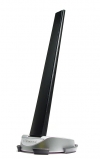Expert tips on extending your home Wi-Fi range


To get some expert tips on maxxing out a wireless signal, I called Jason Owen, director of product strategy at Hawking Technology, a company that specializes in products that help you nab every last inch of Wi-Fi goodness. Hawking markets a comprehensive array of routers, high-gain antennas, range extenders, signal boosters, and even outdoor antennas. Owen says signal-short users can add a combination of this technology to double—and possibly even quadruple—their range.
First, adding a high-gain antenna to your router should give you an easy 15 to 20 percent increase in signal power. It’s simple to install (no settings to tweak) and costs about $40. To further bump the signal, consider adding a signal booster (roughly $90), which amplifies the signal from the router and is a snap to set up. If you’re facile with wireless networking tweaks, you can add a repeater or range extender (about $75 each). In my experience, though, they’re a headache to configure, particularly when you start mixing products from different vendors.
Owen says the most important thing to remember is that, for maximum efficiency, you must upgrade both ends of your connection—your router (or access point) and the antenna on your PC. So if you’ve trying to cover a McMansion, put a signal booster, repeater and high-gain antenna on the router, then add the same on the PC end. You should at least double your range by doing this.
And if you’re aiming to push a signal from building to building, purchase a 15dBi high-gain directional outdoor antenna (expensive at about $180). Owen says the best solution is to attach this antenna to an access point that also has a signal booster. Couple that with the same setup on the other end and, in theory, you can extend your signal up to 5,000 feet using this method.
Owen says that one of most common blunders among wireless users is that they don’t understand antenna technology, which increases range by condensing the wireless signal. “A smaller antenna will give you a ball of wireless coverage. If you put a high-gain antenna on that, it will squeeze that ball into a [horizontal] pancake, which takes away from the coverage at the top and bottom.” He says this phenomenon is particularly notable on omnidirectional antennas, which is why he prefers a directional antenna that “shoots out the signal like a megaphone.”
I’ve been trying to extend my Wi-Fi signal to a neighbor’s house and I’ve tried some of these techniques. I found the signal booster to be particularly effective. But there is one wayward Mac at the farthest point in the house that can’t connect. I’ll let you know when I finally make it happen.